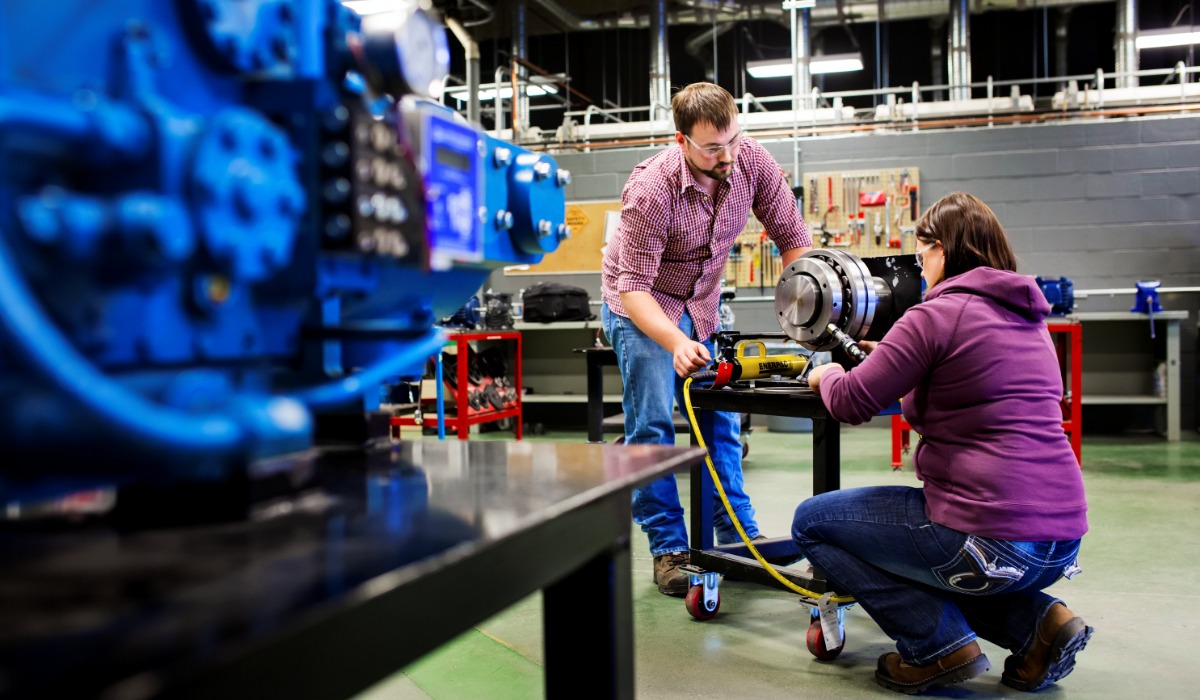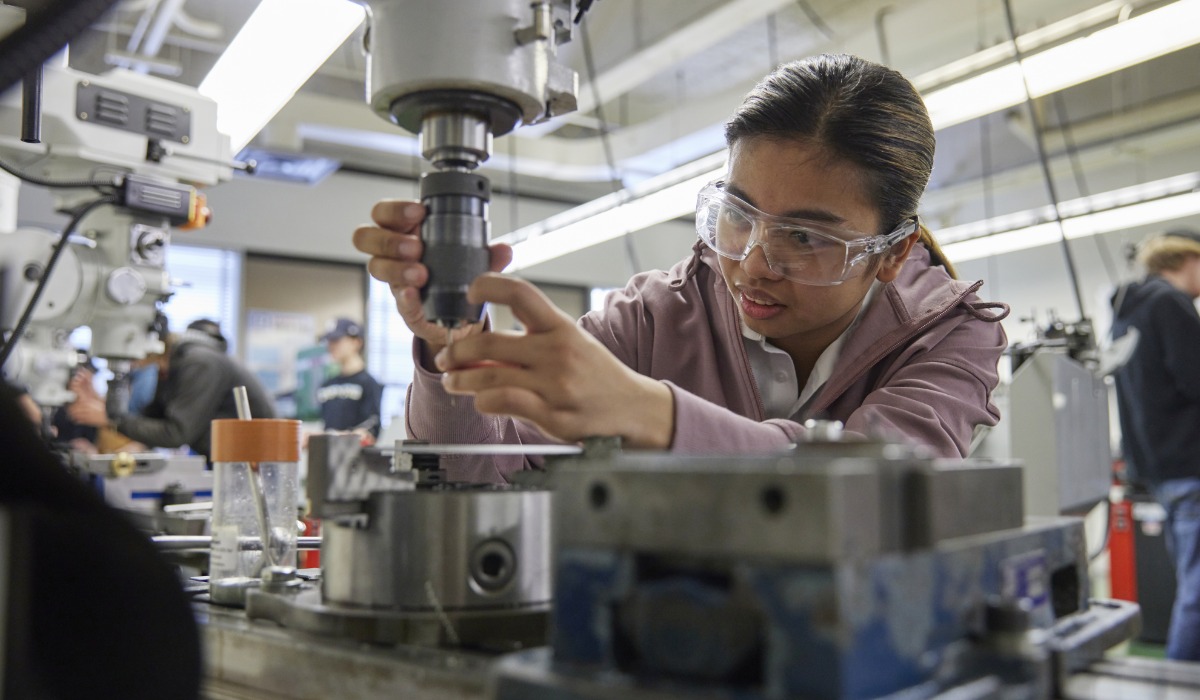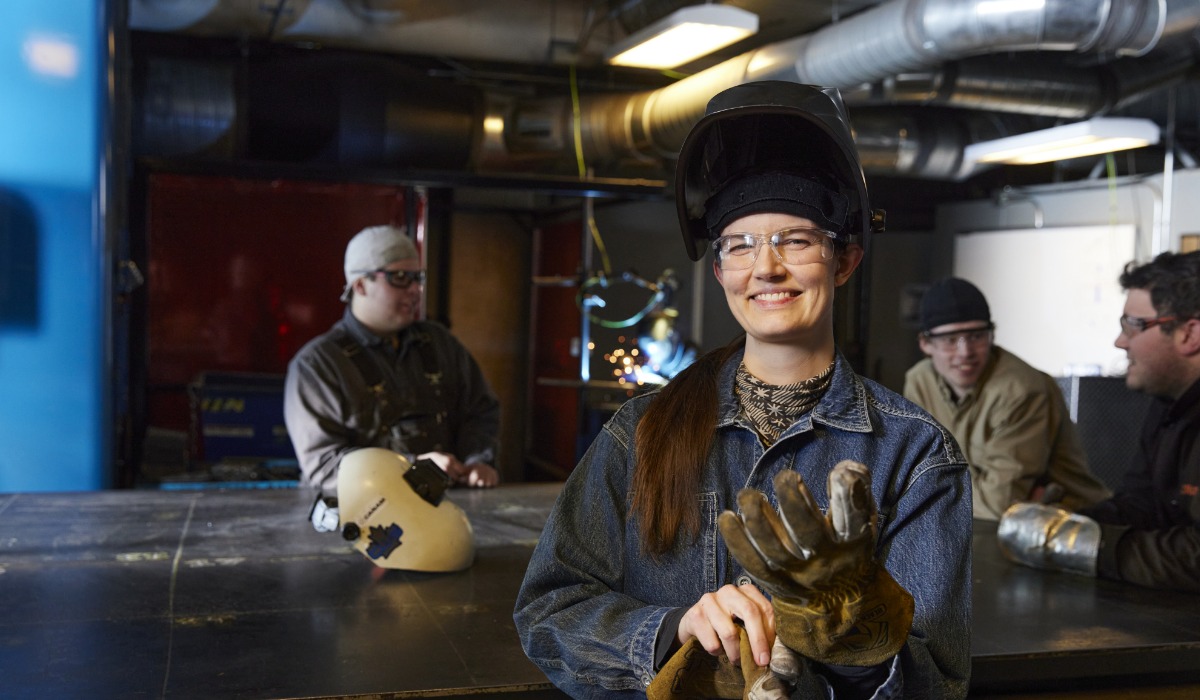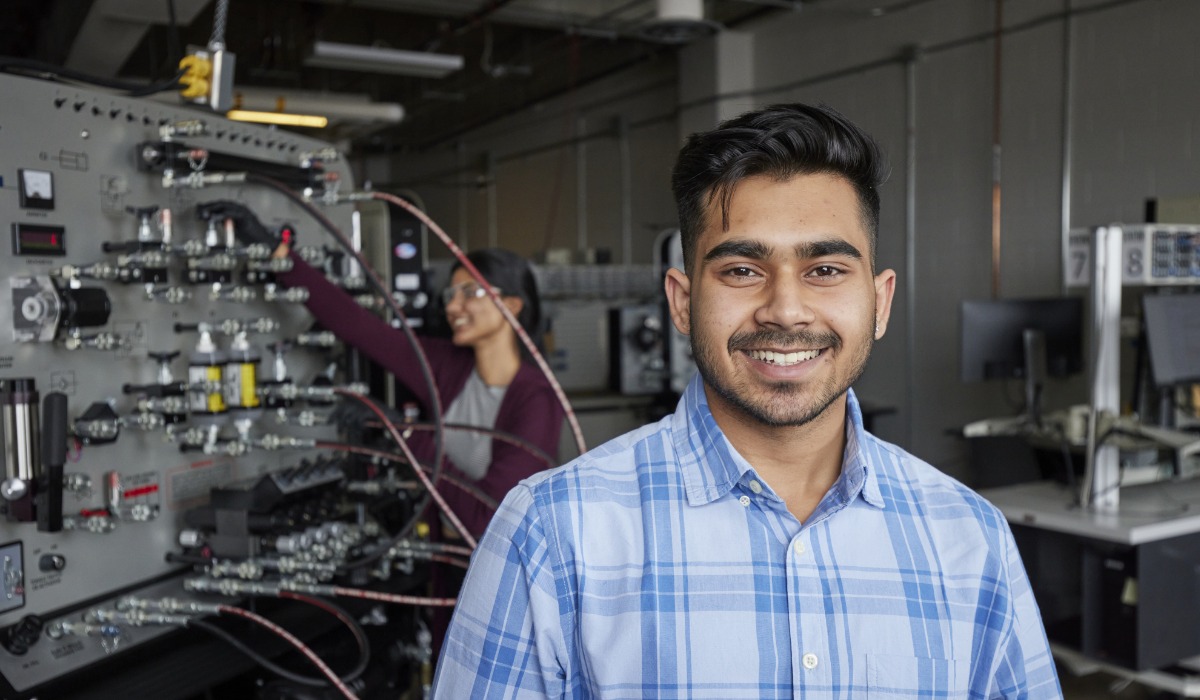Overview
Begin a career in machining, a trade that blends precision, craftsmanship and technical expertise.
Our Machining Technology diploma program offers an extensive, hands-on learning experience, equipping you with the skills to operate precision and Computer Numerical Control (CNC) machinery. These skills are crucial for producing intricate components used across various industries.
You'll build a tech-driven toolkit, gaining proficiency in programming and operating advanced equipment such as CNC mills, lathes, and coordinate measuring machines (CMM).
Additionally, you'll learn to work with conventional mills, drills, lathes and grinders for metal cutting and shaping operations.
In this program, you will:
- learn a broad range of machining technologies and techniques
- learn to set up and operate both manual and CNC machines
- master the art of interpreting blueprints
- be introduced to computer-aided design (CAD) and use computer-aided manufacturing (CAM) software to develop tool paths
- learn how to plan manufacturing processes and validate design accuracy
- gain knowledge in precise measurement techniques and the properties of different metals
- learn the fundamentals of effective communication within a machine shop environment.
This program provides a thorough grounding in foundational and advanced machining technology for those aspiring to become skilled machinists.
Prepare to join an industry where precision, skill and technological expertise come together to create the components that keep our world running.
Those in machining tend to be objective, innovative and methodical.
You need:
- mechanical aptitude
- critical thinking and problem-solving skills
- the ability to use your hands skillfully and quickly
- the ability to estimate and measure sizes and distances accurately
- the ability to work alone on tasks that require concentration and physical effort.
You should enjoy doing creative work with machinery that requires a high degree of skill and precision.
This program aligns with the Alberta Apprenticeship and Industry Training (AIT) curriculum for all four technical training periods for Machinists.
After successfully completing each of the first three semesters, you'll be eligible to challenge the exams for periods one through three. At the end of 60 weeks, you'll be eligible to challenge the period four exam.
Upon passing the exams, you can register as an apprentice and complete the on-the-job training hours to earn your journeyperson designation.
You can complete an optional cooperative work term between your first and second year.
This opportunity allows you to apply your classroom learning in the workplace and gain valuable industry experience while networking with a potential employer.
Upon successful completion of this program, you'll receive a SAIT Machining Technology diploma.
Careers and opportunities
Our graduates may work in the following occupations. Some careers require additional experience and education.
Associated National Occupational Classification (NOC) codes: 22302, 72010, 72100, 72405, 92023, 94105, 94106.
Career planning support
Unsure which career path is for you? Here are some recommended career planning resources to help you decide your future.
You can also head to Alberta alis for lots of information about careers in Alberta, including quizzes and labour market information to help you narrow down a path.
Finally, you can take our online career finder quiz, which can help narrow your options based on your current skills and interests.
Courses
The Machining Technology diploma requires 60 credits (26 courses) to complete.
The program spans two years, with two semesters each year.
| Course | Credits |
|---|---|
|
This course introduces you to the fundamentals of reading manufacturing blueprints, including sketching and dimensioning objects in an orthographic projection. You'll explore isometric drawings and sections, and you'll interpret machine shop drawings containing applied print reading terminology. You'll also examine the use of manufacturing symbols, assembly drawings, and geometric dimensioning and tolerancing. Finally, you'll learn how computer-aided design and manufacturing (CAD/CAM) is used for turning, and you'll describe the use of fasteners and locking devices. |
1.5 |
|
This course focuses on blueprint reading for CAD/CAM (computed-aided design and computer-aided machinery). You will familiarize yourself with the CAD/CAM milling interface to programming and use the CAD/CAM process knowledge to create a 2D drawing specification and manufacture parts. Pre-requisites:
|
1.5 |
|
This course covers the fundamental aspects of computer-aided manufacturing with application to computerized numerical control (CNC). Learners will use software to interface with CNC applications. This includes creating geometry for grooving, threading and profiling applications. Functions and applications of coordinate measuring machines (CMM) to accurately measure components will be explored and students will apply a machine shop estimating process to calculate job costs. Pre-requisites:
|
1.5 |
|
In this course, you'll explore advanced CAD machining processes by creating wireframe geometry, as well as by editing and importing CAD drawings. You will generate tool libraries, and then generate and verify tool paths for advanced milling processes. You'll also get hands-on practice creating a part and manufacturing it in the CNC shop. Pre-requisites:
|
1.5 |
|
Learners will gain an understanding of the strategies and skills required for effective communication in a professional environment. Topics include active listening, conflict resolution, writing industry specific reports and documents, developing interview skills, and giving and receiving feedback. |
1.5 |
|
This course introduces you to the science and technology of metals and alloys. This practical data on basic metallurgy and heat treatment as it relates to the machinist trade will help you make informed decisions about suitable material selection and processes in specific applications. |
1.5 |
|
In this course, you will learn about inspection equipment. You will learn to calibrate measuring tools and gauges. You will also learn about Coordinate Measuring Machines (CMM), and advanced functions of CMM for accurately measuring milled components. |
1.5 |
|
Provides the learner with the opportunities to develop skills in the safe and efficient use of hand tools for measurement, layout, metal cutting and assembly work. Learners will also operate pedestal grinders, drilling machines, power saws, engine lathes, drilling machines and milling machines. Basic heat treatment will also be included. Also, this course introduces safe working habits while working with and around oxy-fuel gas cutting and welding processes. |
3 |
|
This course introduces you to the fundamental theory you'll need to work safely and effectively as a machinist. You'll begin by examining important safety regulations, as well as procedures for working with hazardous materials, and for climbing, lifting, rigging and hoisting. You'll examine taper systems, screw threads and measuring tools, as well as the lubricants and cutting fluids used in the trade. You'll also explore the types and operating procedures of a variety of tools and equipment, including oxy-fuel tools, hand tools, layout tools, drills, drilling machines, power saws, lathes and grinders. |
3 |
|
This course provides you with hands-on experience to develop advanced machining skills by using a variety of manual machine tools. Vertical and horizontal milling machines will be emphasized, as well as lathes. This course puts into practice the theoretical concepts of the second-period machinist apprenticeship program and includes an introduction to machining castings. Pre-requisites:
|
3 |
|
This course builds on the theoretical knowledge from the first semester courses and introduces new concepts. Classes will emphasize advanced milling operations and advanced tooling. Additional theoretical concepts required in the second-period machinist apprenticeship program will also be presented. Pre-requisites:
|
3 |
|
In this course, you will develop advanced skills in precision machining techniques. These techniques will include using drawing specifications to manufacture spur gears, prismatic parts and features, and cylindrical parts and features. You will also assemble manufactured parts of a model wind turbine. While learning these techniques you will review safety procedures, read blueprints, perform heat treatments, and other related tasks. Pre-requisites:
|
3 |
|
This theory course covers gear manufacturing methods and applications. This will include learning gear terminology, calculations, and the setup and operation of grinding machines. You will also learn about the process of manufacturing gear systems, characteristics and applications of multi-start and worm threadings, abrasives and grinding wheels, fixtures, and machine broaching. Pre-requisites:
|
3 |
|
In this course, students will build upon their knowledge learned in previous machining courses. Following instructor demonstrations, students will complete a series of projects, including project prep, boring mill operations and worm wheel manufacturing. The final project will require students to manufacture a functioning dividing head. Pre-requisites:
|
3 |
|
In this high-level machinist course, students will focus on the use of boring mills in the industry, bearings and seals selection and installation, and specialized machining processes used in manufacturing. Throughout the course, there will be an emphasis on safety practices and alignment with industry standards. The course will also provide an overview of the Skilled Trades and Apprenticeship Education Act (STAEA) as it pertains to the the industry and the importance of the Red Seal Program. Pre-requisites:
|
3 |
|
This course introduces you to the fundamental mathematical principles that you will need to meet the requirements of your program. You'll explore the trade applications of whole numbers, fractions and decimals, as well as metric and imperial conversion and geometric problems. You'll perform algebraic operations and use ratios, proportions and percentages to solve trade-related problems. |
1.5 |
|
This course is designed for students who are pursuing a career as a machinist technician or in a similar field. You will build on the math skills you've learned in the program and apply them to more complex trade-related problems, with units focused on geometry, trigonometry, measurements, conversions, ratios and proportions. You will also learn to use the Machinery's Handbook to interpret tables, charts and graphs, and to perform calculations and apply geometric concepts to solve shop-related problems. Pre-requisites:
|
1.5 |
|
This course is designed for students who are pursuing a career as a Machinist Technician or similar field. You will learn to perform calculations to solve problems in trades-related applications using the Machinery's Handbook. You will also learn to apply trigonometry concepts to calculate dimensions and fits, to design gauges and solve machining problems. Finally, you will learn the fundamentals of logic-based statements and arguments. Pre-requisites:
|
1.5 |
|
In this course, you'll learn how to manually program and safely operate computer numerical control (CNC) turning centres, including using control panel functions, performing system setup and manipulating offsets. You'll also get hands-on experience building and executing a series of lathe profiles to meet specifications. |
3 |
|
In this course, you'll learn the basic theory necessary to operate computer numerical control (CNC) turning centres. You'll explore the safety procedures, basic concepts and applications of CNC machines, as well as the purpose of co-ordinate and reference points used for CNC machining. You'll analyze the structure of the CNC format and code structure and you'll execute and verify manual programs. Finally, you'll examine CNC turning machine setups and offsets. |
1.5 |
|
The course allows you to apply the theory material covered earlier in the program to the machining process. Topics will include basic start-up and maintenance, as well as set-up and operation of computer numerical controlled (CNC) machines. You will create a fixture for a name plate using a provided drawing, then manufacture and engrave that nameplate. Pre-requisites:
|
1.5 |
|
This course allows you to set up and operate computer numerical control (CNC) machining centers. You will perform functions such as setting tool length offsets, radius offsets, inputting programs, using canned cycles and creating programs. You will also be editing and inserting offsets, as well as changing tools. Pre-requisites:
|
3 |
|
This course will build on the knowledge and skills you developed in previous semesters. Specifically, this course covers codes and formats, linear and circular interpretation, canned cycles, multiple repetitive cycles, tool nose radius compensation (TNRC), Computer Numerical Control (CNC) threading and programming, and tool measurements. By exploring these topics, you will learn about linear and circular tool path methods, threading tools and cycles, and other important topics related to CNC operations. Pre-requisites:
|
3 |
|
In this shop course, you'll further develop your skills in operating a Computer Numerical Control (CNC) lathe. You'll complete multiple projects that involve writing and executing the program, running the threading cycle, taking measurements, demonstrating safe setup and operation procedures, using drawing specifications, applying thread calculations and performing finishing operations. |
3 |
|
In this course, you will learn advanced programming techniques for machining centers. This will include learning how to demonstrate canned cycles used for drilling, boring and tapping operations performed on CNC machining centers; and using linear and circular interpolation for profile and thread milling operations. You will also write a program that uses rotary axis on machining centers. Pre-requisites:
|
3 |
|
In this advanced shop course, you will apply some of the key concepts and skills you covered in previous CNC courses. This will include starting and setting up a machining center, setting up workholding for multi-axis machining, and using canned cycles for drilling, boring and tapping operations. You will also apply advanced programming concepts and applications for machining centers. Pre-requisites:
|
3 |
| Course | Credits |
|---|---|
|
The cooperative work term course offers students an optional opportunity to augment their classroom learning by applying theoretical knowledge and gaining practical experience in a professional workplace setting. This course serves as a bridge between academic studies and real-world industry practices, enabling students to develop valuable skills, enhance their employability, and establish connections within industry. |
0 |
Progression
You must attain a PGPA and/or a CGPA of 2.0 or better each semester and pass the prerequisite courses to progress through the program.
To qualify for graduation, you must pass all courses, attain a CGPA of 2.0 or better and complete course requirements within the prescribed timelines.
Admission requirements
Applicants educated in Canada
Applicants must demonstrate English language proficiency and completion of the following courses or equivalents:
- at least 50% in Math 20-1, Math 20-2 or Math 20-3, and
- at least 50% in English Language Arts 20-1 or English Language Arts 20-2, and
- at least 50% in Science 10.
Applicants who have previously completed the SAIT Machinist Technician certificate program or equivalent may also be accepted in place of the above requirements.
SAIT accepts high school course equivalents for admission for applicants educated outside of Alberta.
All applicants who were educated outside of Canada must demonstrate English language proficiency and provide proof they meet the program admission requirements outlined above with an international document assessment. Find accepted educational documents and assessment options.
SAIT may also accept courses completed at certain international post-secondary institutions.
Academic Upgrading
Missing an admission requirement for this program? Upgrade your prior education to help you receive admission into one of SAIT's career programs.
English language proficiency
All applicants must demonstrate English language proficiency prior to admission, including students educated in Canada.
Transfer agreements
At SAIT, we have created transfer agreements with partner institutions to allow you to earn course credits toward your SAIT program based on your previously completed credentials.
Transfer Alberta search tool
Use the Transfer Alberta search tool to see all transfer agreements between Alberta post-secondary institutions (including those with the University of Calgary, Mount Royal University and Bow Valley College.)
Search transfer agreements in Alberta
Transfer options for graduates
When you have completed this program, you may continue your education at a partner post-secondary institution. These transfer agreements include partnerships within and/or outside of Canada.
Available intakes
Fall 2026
Start dates:
- Domestic students: Open
-
-
Application deadline: June 30, 2026
-
- International students: Open
-
-
Application deadline: May 29, 2026
-
Costs
2025/26 tuition and fees
The following costs are effective as of July 1, 2025.
The estimated total cost of tuition and fees is based on the suggested schedule of study. Following a modified schedule will impact the fees you pay per semester and may alter final costs.
Domestic students
The program total is based on the estimated amount you will pay if you enter this program during the 2025/26 academic year. The program total amount listed on your letter of admission may appear higher. This amount is your maximum tuition guarantee for the program. SAIT will not exceed this maximum, regardless of changes in tuition and fees between academic years.
Books and supplies are approximately $2,000 per full-time year.
This is a bring-your-own-device program with a standard computer hardware and software requirement. See the specific requirements on our computers and laptops page.
Find your booklist on the SAIT Bookstore's website. The booklist will be available closer to the program start date. Can't find your program or course? The bookstore didn't receive a textbook list. Contact your program directly to determine if they're still refining course details or if you're in luck; no textbook purchase is required this term.
Financial aid
Paying for your education may feel overwhelming, but we have resources and programs that can help, including information about payment options, student loans, grants and scholarships.
Application process
Ready to apply?
Follow our step-by-step guide to submitting a successful application.
Communication during admission
Email is the primary source of communication during the selection process. Ensure your personal email account is managed appropriately to receive our emails, files and communications. We recommend you add the ma.info@sait.ca domain to your safe senders' list or you risk missing critical email messages.
Begin your application
Apply now using the online application portal.
Ensure you have a valid Visa or Mastercard to pay the non-refundable application fee of $120 for domestic applicants or $175 for international applicants.
Information sessions
Prepare for a strong start in your chosen program or get the details you need to decide your future path.
Our expert staff and faculty are ready to answer your questions and provide information about the following:
- What sets SAIT apart
- An introduction to the program and area of study
- Admission requirements
- Future career paths
- Information on the earning potential and graduate employment rates.
Contact us
School of Manufacturing and Automation Advising
-
Phone - 403.284.8641
-
Email - ma.info@sait.ca
International Student Advising
-
Phone - 403.284.8852
-
Email - international@sait.ca
Subscribe for updates
Your journey starts here! Sign up to get important updates on:
- Manufacturing and automation programs
- Application information
- Relevant news and events

Oki, Âba wathtech, Danit'ada, Tawnshi, Hello.
SAIT is located on the traditional territories of the Niitsitapi (Blackfoot) and the people of Treaty 7 which includes the Siksika, the Piikani, the Kainai, the Tsuut’ina and the Îyârhe Nakoda of Bearspaw, Chiniki and Goodstoney.
We are situated in an area the Blackfoot tribes traditionally called Moh’kinsstis, where the Bow River meets the Elbow River. We now call it the city of Calgary, which is also home to the Métis Nation of Alberta.




